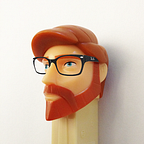I produced a 16 page book chronicling my decade in music. It is a limited edition of 200 copies with some of the charts above and more. It was printed with hot pink ink on light pink paper that you have to see in person. Order a copy here.
One of my favorite bits of the internet is the Carl Sagan apple pie recipe created by a user on Reddit. It takes the famous Carl Sagan quote about making an apple pie from scratch and makes it literal, providing the ingredients and instructions for true scratch apple pie.
There are two details that I love: “Preheat oven to 375 F. Make the universe as usual” and “Preparation time: 12–20 billion years”. It acknowledges that everything good is predicated on the time and energy spent in creating it. It’s an acknowledgement of the ultimate long game. As if the inevitable destiny of the universe is a warm apple pie.
Preheat oven to 375.
Some people follow sports, others follow politics or fashion trends or the weather. Some are causal followers and others are more religious about following, making sure they never miss a moment of the thing they love. For me, the thing I follow more than anything else is music. Since the time I had money of my own to spend, most of it was directed towards music. In that sense, I had been preheating the oven for years.
My big bang moment came at the end of 2009 when I was spurred by curiosity to write down every new album I heard for the next 10+ years. My universe wasn’t made in that moment, but with a preheated oven the first spark set off a long chain reaction that led me to where I am today.
And I stuck with it, year after year. Tracking and then making. Collecting and then refining. One annual report after another. Each built on what I learned the previous year.
Make the universe as usual.
The process of tracking my music habits has evolved and become more complicated. The yearly reports have become more dense. The stories I have found in the data have become more interesting. But the process of making the report each year has not changed much at all.
Starting in November or December, I will begin figuring out how to track the data for the following year. I will run experiments, try out methods, and figure out what can be sustained for 12 months at a time. Then starting on January 1, I begin the year long grind of collecting data. On December 31, I end my data collection and the following day I begin compiling, cleaning, and analyzing the data. I also begin to plan out the printed report.
The report itself requires a lot of iterations and a lot of back and forth between the data and the design. Here’s an example of the evolution of a single page:
The first version of the page is empty because I am not even sure what the story is to be told. And then the idea emerges. I may pull from old experiments to remind myself of the idea. Then the big blocks start to form, especially the biggest graphic. The design language isn’t fully formed for a while. But then the colors, typography, paper, and page layout begin to solidify. From that point it’s about filling out the page and cutting the unnecessary parts.
The pieces inside the page undergo similar explorations and refinements. Here is an example of the main chart from the page above:
At first, it’s about getting a rough visualization of the data. Then there are iterations on the form. After that, it’s about making sure the story is salient. In this particular chart, there were two pieces of data competing with each other, the names of the artists and the number of times I listened to them. In the end, I felt like the names of the artists was the more important and interesting piece of data, so I scaled back the presence of the listening data. The final tweaks are made to get the graphic print ready.
Each data point, each chart, each page, are all made as usual — iterating until the pieces fit together. Or as the recipe says, until golden brown.
Preparation time: 12–20 billion years
The point of the art is the doing of the art — that long, hard work that leads to the sweet reward at the end. The long work of planning, collecting, compiling, and then enduring the doing of the work. That has been my decade in music project for me.
I love art that is a marathon, not a sprint. Art that acknowledges the long process in one way or another. Sohei Nishino’s photo collages. Ai Weiwei’s Sunflower Seeds. Ragnar Kjartansson / The National’s A Lot of Sorrow (6 hours of the bandplaying the same song). The movie Boyhood. This is the work that inspires me.
The preparation is the art itself. The process is indistinguishable from the final product. Both are part of the story. Without the process or the product, the art would be less meaningful. This isn’t a new idea. Artists have been mining this idea for centuries. I call it out because it is why I stuck with this project for over 10 years. The process of collecting the data and designing the report was as rewarding as having a tidy print at the end of each year.
I produced a 16 page book chronicling my decade in music. It is a limited edition of 200 copies with some of the charts above and more. It was printed on a risograph with hot pink ink that you have to see in person. Order a copy here.
Previous year’s projects are compiled on my website: www.ericboam.com
